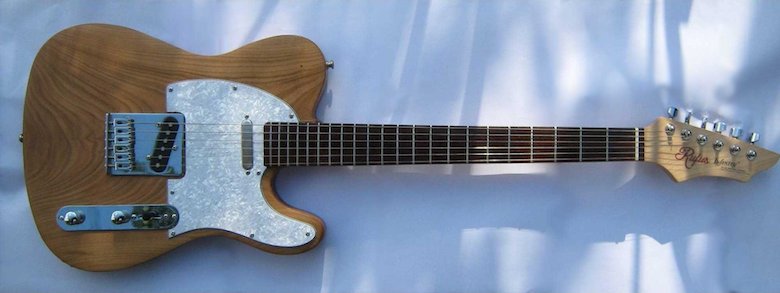Barking up the Right Tree
Building a guitar is all about the wood, something that Sean Rufus Williams from Rufus Guitars was keen to point out when we spoke to him about what makes a great guitar.

‘It's like the birth of a child - especially when the neck goes on,’ said Sean Rufus Williams from UK builder Rufus Guitars, when we asked him how it felt to make a guitar. ‘A guitar starts out as three or four blocks of wood and ends up as something completely different! It's really funny; when I pick-up a guitar that I've made and not seen or played for a while, it's almost as though I don't recognise it - but when I hold it, play it and look at it closely I can remember the different processes that went in to creating it. The biggest satisfaction is the when I give the guitar to someone who really loves it,’ he adds.
Those sentiments echo those of many of the guitar builders we’ve spoken to. That mixture of relief, joy, and pride at seeing their creative efforts in the hands of someone who can get the best from it.
We asked Sean how he started making guitars. ‘Unlike many guitar makers, I was never interested in fixing other peoples guitars - I just wanted to go straight in to building my own,’ he explained. ‘I wanted to make ones that I would want to own.’
Before he made his first guitar, though, Sean experimented on a couple he already owned. ‘I had a Japanese Les Paul copy, a Satellite, when I was about 13 or 14. I took it to bits, stripped it, painted it blue and fitted Di Marzio humbuckers - it was terrible! I later did a similar thing to a Japanese Jedson Tele - painting it black and fitting a humbucker in to the pick-guard between the neck and bridge pickups. That worked out a little better.’
The Telecaster has been a big influence on Sean; he describes it as ‘the greatest guitar ever made,’ but he also cites Patrick Eggle, John Smith, and Trev Wilkinson as influences. And Sean is happy to learn from the guys who play his guitars. ‘It still amazes that they can produce the sound they get from a block of wood with some wire nailed to it,’ he says enthusiastically. ‘Lem Mellor was (and still is!) a big influence and a great supporter of our guitars. Also, meeting Lee Wylding of the Fireflys was a game-changer for me - after talking to Lee I realised that if I made guitars that I wanted, then so would other people. Lem and Lee are always so positive and upbeat about our guitars - that was a huge help.’
As we have done with other guitar builders we’ve interviewed, we asked Sean for advice for those just starting out. What’s most important to get right? ‘It's the body wood, everything else is a technical exercise - the fitting of the neck, the scale, the pickups, the bridge and nut, the finishing laquer are all things that require expertise, but you can’t fake the feel that real wood gives to a guitar. My ideal would be a single piece of cherry for the body, preferably with plenty of swirls through it; cherry is only a small tree, so it has has plenty of knots that produce the swirls that you see in the grain - I think maybe this is why cherry gives such great resonance. Other woods I think are great for guitar making are elm, pear, ash and walnut - all British, of course.’
Sensing that Sean was enjoying passing on his expertise, we pushed for more. ‘If you have a good quality body and neck, everything else can be upgraded. For a new guitar builder, it really depends on their expertise and budget. If you are very new and have no experience at all then it can be quite daunting; in that situation the first thing I would do is buy a very cheap guitar on eBay (i.e. less than £20) and strip it, then rebuild it; you will then have the expertise to tackle a real one. You can always resell the guitar again and recoup most of your money. After that, maybe either a kit or build your own from parts and your own body cut from wood. Making a neck is quite complicated and so practice a few time first with cheap wood. The most important part of any guitar build is how the neck meets the body, either glued or bolted-on - and this requires practice.’
When it comes to tone, Sean is pretty relaxed. ‘I don't think tone is the real issue - it's more about feel,’ he says. ‘When you pick up a guitar and hit a string, the feel of the vibration, the decay of the wave, how the neck sits in your hand - it all adds up to how the instrument feeds back information to the player. I have met some pretty talented guitarists and without exception, they play our guitars without plugging them first; at that point, with no amplification, it is all about feel and not about tone.’ After all, says Sean, ‘with an array of effects pedals you can pretty much get a Strat to sound like a Les Paul and vice versa.’ And that, of course, is more true now than ever with the wide range of computer and mobile device amp modelling programs available.

Recently on Guitar Hive
-
Electric guitar strings - make your next set the best you've ever played
Apr 23, 15 02:06 PM
There are so many different types and brands of electric guitar strings on the market, buying a set can be confusing. Here's how to choose the best set for you. -
The guitar neck – types, profiles, and everything else you wanted to know
Apr 17, 15 02:24 PM
The guitar neck is the most personal part of the instrument. No wonder it comes in so many shapes and types. -
The neck fingerboard radius explained
Apr 15, 15 06:01 AM
The neck fingerboard radius is one of those seemingly complicated features that's really very easy to understand.
On eBay...




New! Comments
Have your say about what you just read! Leave us a comment in the box below.